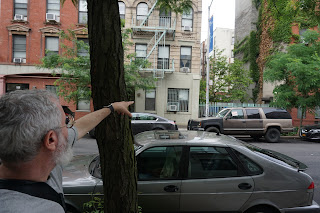 |
| Landscape-garbage-bag-8th-between-b-and-c and other photographs by Ken Schles. |
Some
days the city opens up in wonderful striking ways. Between the ups and downs of summer, I had
scheduled a PhD defense at 1 PM at 119 Street and Third Ave. It was raining when I rode out into the city
for the ride, crossing over the Manhattan Bridge, through Chinatown, past the Bowery
and up to 3rd Ave in less than an hour. Wow. I couldn’t believe I had 15 minutes to
spare. I almost never find myself uptown anymore. But for years I was up here, taking the train
from Brooklyn every day. Finishing the
defense, I had all afternoon to myself and
started thinking.
How do I keep challenging myself?
What’s
the next step I thought riding back downtown.
It
was a dozen years ago that I was in the same room.
Now
I’m conducting the sessions.
What
happens to us in the city?
Do
we become invisible?
Does
this city consume and envelop us?
These
are some of the thoughts I have looking at the work of Ken Schles. There is a chapter
in my novel, Illuminations on Market
Street, in which I dream of sleeping in a hotel lost within my life, with the
minotaur chasing me through the dark labyrinth.
His black and white photographs from Invisible City seem to conjure up
that feeling.
We
were going to talk about his photographs and explore the city, after becoming friends
in DC during the waves of actions defending the ACA.
And
in Albany, he drove me home after one of the waves of civil disobedience over environmental policy this spring. We chatted all the way.
Ken Schles is a photographer and
writer, the author of five monographs. A native New Yorker, Schles currently
resides in Brooklyn, NY. He is a graduate of Cooper Union for the Advancement
of Science and Art and studied with Lisette Model at the New School for Social
Research. Born in 1960, he grew up in a turbulent era and has been engaged in the
issues that have shaped his world. As a student at Cooper in the late 70s and
early 80s, he helped revamp an ailing photography department. In the 1980s he
documented his life in the underground art and club scene and lived in what
became an abandoned tenement in the East Village… The work he made
at the time became material for two books, Invisible City(Twelvetrees Press,
1988), which was named a New York Times notable book of the year upon
publication and, when reissued in 2014, was named a TIME Magazine photobook of
the year. Invisible City has appeared
in four histories of the photobook, including Parr/Badger's seminal The Photobook: A History (Phaidon,
2014) and the recently published New York in Photobooks (Editorial RM and Centro José Guerrero 2017). A second
book, Night Walk (Steidl,
2014) was also named book of the year by TIME Magazine. Together the exhibited
work was nominated for the 2016 Deutsche Börse Prize.
Ken
agreed to meet me to talk about photography and the city on Wednesday.
While
we’re both Brooklynites, we both have bikes and can travel.
So
we met at the Slocum Memorial Fountain, a memorial for a boat that caught fire
and sank in the East River on June 15, 1904.
Some 1021 people died.
Right
behind the bathrooms at the park, the space reminds of all those days doing
community service in the park, I told Ken, who toured me through the spots that
inspired Invisible City. Past the Christodora and a bodega that had been a gallery where he
showed his work, Ken chatted with neighbors, pointing to spaces he photographed
in the book. Past Basquiat’s old apartment
and a garden he helped form, we chatted about the changing city, art and the East Village scene. We stuck our
head in the old Life Café. I only lived
here for two years, but it the place I am most comfortable in New York, I confessed.
This is my old apartment, he counseled standing next to Mona’s Bar at 224 Ave B.
I have not been here for twenty years,
but my name is still on the buzzer. On we walked, past Rays Candy Store, across from the
Park, where I bought some beignets for the kids. Ray is buying a new ice cream machine. But it costs $14,000. The city will break your heart. But Ray is here. Ken and I rode back to Brooklyn, talking
about the challenging of photographing a city in constant flux.
Maybe
this is how you document change, noted Ken, sending me a text message for an
action the next day.
Caroline
and I cooked later that, making our way to House of Yes, for dancing into the
summer night at the Summer Seduction Party, laughing and shaking at the only at
House of Yes vibe taking place there, live dancers and performers, a random saxophone,
lots of gyrating bodies.
Some
days, New York still has it. Wednesday it felt like one of those days.










































































No comments:
Post a Comment